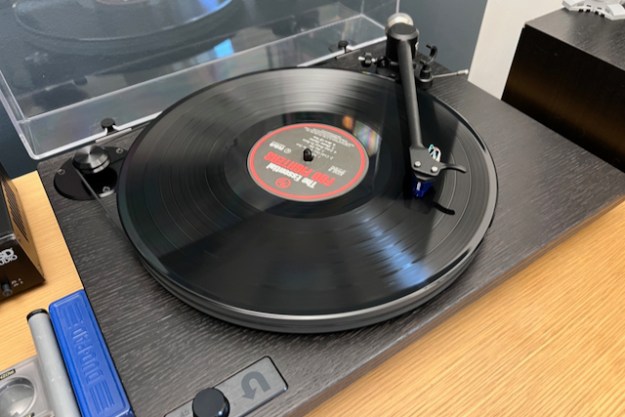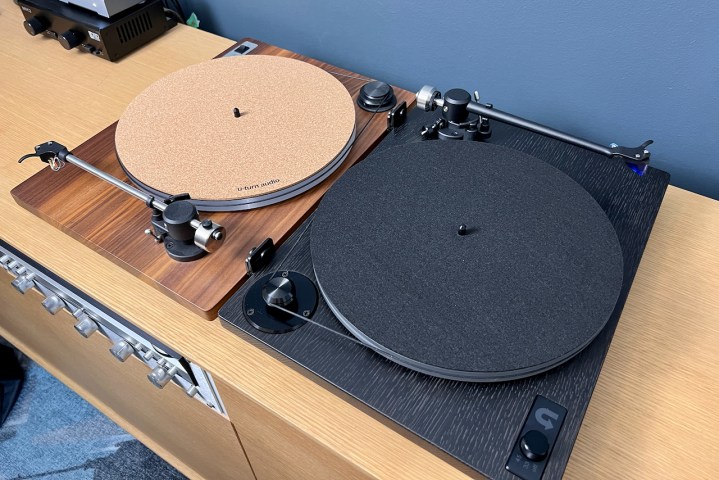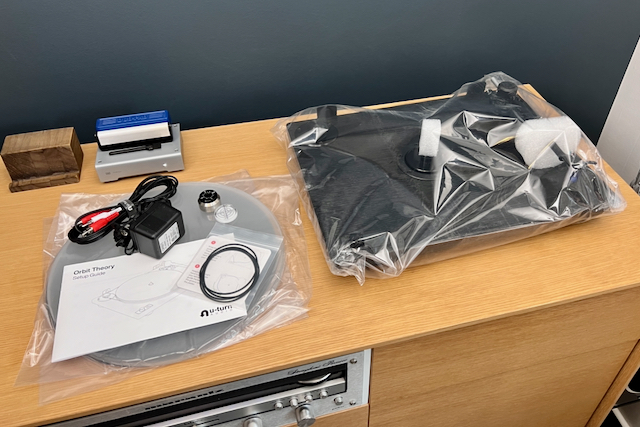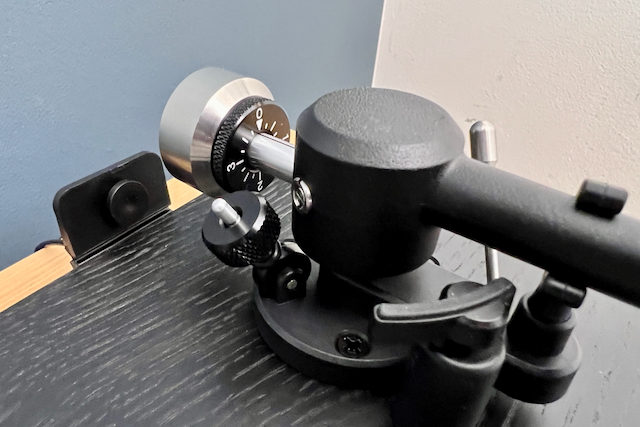
- Ortofon 2M Blue or Bronze cartridge
- New antiresonant tonearm design
- Easy to set up
- Electronic speed switch dial
- Built-in preamp option
- Fantastic sound for price
- Only two finish options
- No auto stop
If you’re at the stage in your record-collecting odyssey where you’re considering upgrading your entry-level turntable, you’re probably well aware of big names like Rega and Pro-Ject. But if you’re the type that likes to veer just off the beaten path for gear that can go toe-to-toe with those big shots while adding something a little different to your setup, Woburn, Massachusetts-based U-Turn Audio has recently ventured into premium territory with the Orbit Theory, its best turntable yet.
Priced between $999 and $1,249 (depending on the cartridge/preamp configuration you choose), the Orbit Theory builds on U-Turn’s 10-year-old Orbit turntable brand with a totally rethought unit that features a new magnesium tonearm design, upgraded drive system, and a list of other enhancements. A U-Turn Orbit Custom has been my go-to record player since I purchased it in 2018, and I’m pleased to report that the Orbit Theory has pretty much solved every gripe I’ve had with that deck over the years, making the Theory my favorite turntable I’ve ever reviewed. Here’s why.
Setup
Setting up the Orbit Theory is quick and painless, It does have some assembly required, but it takes a little less than 10 minutes. In the box, you’ll find everything you need, including the platter and slip mat, RCA cables, power supply, drive belt, counterweight, a horizontal spirit level, and setup instructions.
The main plinth unit (the wood base of the turntable) is the last thing you’ll pull out of the box, well-packed with foam and protected. The tonearm comes with your chosen cartridge, preinstalled and aligned, and the instructions for getting the counterweight properly balanced and the anti-skate mechanism set are clear and easy to follow, even without a digital force scale gauge.
The Orbit Theory is like an older sibling who went to college and got a degree.
I have to give props here to two of the Theory’s design upgrades that make setup (and operation, but we’ll get into that below) infinitely easier than all other Orbit models. The new motor spindle design is a solid piece of grooved aluminum that doesn’t budge, and a new machined groove around the outside edge of the acrylic platter makes installing the silicone belt around it a piece of cake — it’s usually clumsy as hell, with the belt sliding off the platter’s edge over and over again. Thank you, U-Turn. And once it’s installed, you won’t have to touch it because of another design upgrade, an RPM speed-selection dial (again, more on this later).
Features and operation

The Orbit Theory turntable, and others of its ilk, like the Rega Planar 3 and Pro-Ject Debut Pro, are dead simple to operate mechanically speaking — and they should be. Putting a record on a turntable is a ritualistic experience that shouldn’t get in the way of the music, and the Theory doesn’t. Fundamentally, the Theory’s design isn’t too far from its other Orbit relatives, but it feels more refined — like an older sibling who went to college and got a degree — and that’s all thanks to the following components:
Redesigned magnesium tonearm
All eyes are on the Orbit Theory’s redesigned tonearm, the OA3 Pro, which is made of a single continuous piece of molded magnesium that includes the headshell, armtube, and pivot housing in one. U-Turn says that this unified design makes for a tonearm that is lightweight, strong, and has no assembly connection points between components, resulting in less resonance.
The counterweight gets a much-needed upgrade too, with a more precise numbered measuring dial, which is why you no longer need a tracking force gauge at setup — there’s no guesswork. U-Turn has also switched from the OA2’s internal anti-skate to, again, a more precise external system for better fine-tuning based on the cartridges you choose. These features are a welcome upgrade for those of us who like to occasionally check and calibrate our turntables, switch cartridges, or troubleshoot sound issues.
Drive system and speed control

One of the most exciting details about the Orbit Theory is its drive system/speed control. U-Turn says that it’s more powerful than previous Orbits and virtually silent, and I can attest to both claims. It’s a solid aluminum piece that’s mounted directly to the wooden plinth.
A single groove in the spindle replaces the dual 33/45 RPM grooves found on all other Orbit models that are necessary for manual speed change. Yes, it seems archaic, but on so many turntables, including several high-end models, switching to and from 33 to 45 RPM is done by manually moving the belt from one spot on the spindle to another. Thankfully, U-Turn has seen fit to do away with this practice on the Theory, opting for an electronically controlled DC-powered motor that moves speed switching to an elegant knob mounted on the front left of the plinth. Hallelujah!
Simply put, the U-Turn Orbit Theory is my favorite turntable. Full stop.
I even like to use the 45 RPM setting to more quickly run my antistatic brush over my vinyl before lowering the included cue lever. Oh, and the belt is now made out of a molded silicone that doesn’t stretch out over time (like it would from all the manual speed switching).
All hail Ortofon

As mentioned above, the Orbit Theory offers two excellent Ortofon cartridge options, the 2M Blue at the base $999 price, and the 2M Bronze for $180 more. Ortofon’s 2M cartridges are some of the best in the business, and U-Turn has been using them for years. They’re known for their vocal clarity, definition, and versatility, with a wide range of music making them a great all-around range of cartridges.
But which should you choose? While the 2M Blue will be great for most people, the 2M Bronze offers a wider soundstage and slightly better instrument separation. One last thing to consider before choosing is their upgradability. With the 2M line, you can interchange styluses with certain cartridges, which is good to note for future-proofing.
Take the Blue pill and you’re at the top-end of its range — you can save some money, though, by switching to the still-great Silver ($109) or Red ($87) styluses. Take the Bronze pill and open up upgrade options for Ortofon’s top-end Black ($575) and Black LVB 250 ($800) styluses. Choices abound.
But getting back to the cartridges on the Theory, it should be noted that on their own, the Blue and Bronze cartridges retail for around $240 and $420 each, respectively, making the Theory a great value at just over the $1,000 mark.
Connections and phono preamp
If you’re looking for a turntable to rip your vinyl into digital files, you’re barking up the wrong tree here. The U-Turn Orbit Theory has no USB connectivity and doesn’t do Bluetooth or Wi-Fi, but that’s fine by me. What it does have, however, is a pretty great built-in phono preamp, U-Turn’s Pluto 2, which can be added internally for $70, or purchased separately as an external unit for $99.
Depending on your amplification decisions, the preamp has a bypass switch to turn it on (for connecting to an AUX line in on a receiver, or a set of powered speakers without a phono input) or off (for receivers or powered speakers with phono inputs). Of course, you can always get your own external phono stage and tweak the sound exactly to your liking.
Happy feet
Vibrations and resonance are the enemies of any turntable setup, and if you’re not going to use a sound isolation platform like the IsoAcoustics zaZen, then it’s important that your turntable has a decent set of feet. U-Turn apparently got that memo too, adding a pretty sweet trio of height-adjustable aluminum feet to the Orbit Theory that are layered with sound-isolating Sorbothane — and it works. Compared to other turntables I’ve tested without such technology, the Theory is less sensitive to footfalls and light tapping on the table around its base being picked up by the stylus than most. In short: it’s quiet.
Finishes
While you don’t get as many finish options as you do with other Orbit turntables, the Theory’s hardwood plinths have natural antiresonance properties and come in walnut and what U-Turn calls Ebonized Oak, a black finish achieved through a chemical oxidization process without staining. I do prefer the walnut, but the darker oak is a unique option.
Performance

I’ve been using the U-Turn Orbit Theory for nearly four months now, and as I mentioned in the intro, it has replaced my Orbit Custom and even my fantastic Fluance RT85 as my primary decks. Simply put, it’s my favorite turntable. Full stop. But let’s dig into why I like it so much.
No matter the setup I’ve put this turntable through, it performs amazingly well and sounds fantastic.
The Orbit Theory review unit I received is in the Ebonized Oak finish and came outfitted with the built-in phono preamp and the Ortofon 2M Blue cartridge, which I am very familiar with as I use them on several of my turntables — they sound great.
I’ve run the Theory through both my modern Cambridge Audio AX100 receiver, as well as through my vintage Marantz 2226, using a combination of the turntable’s internal preamp, the phono inputs of both receivers, and an external Schiit Mani phono stage. For speakers, I’ve switched back and forth between a pair of Wharfedale Diamond bookshelf speakers and a fantastic pair of rebuilt Mission 727s from the early 1980s that have great low-end.
I mention this only to say that no matter the setup I’ve put this turntable through, it performs amazingly well and sounds fantastic, delivering detailed, clear sound that is adaptable to a wide range of gear — old, new, big, or small.
I’ve had the time to put the Orbit Theory through its paces with all kinds of records too. And while you can give a lot of credit to the all-rounder 2M Blue for its forgiving nature (the 2M Bronze even more so, if you can swing the extra $180), everything I tossed at the Theory sounded consistent and balanced, with a realistic soundstage true to each artist. The only coloration came from the speakers and preferred EQing I put on them.
I suppose I was waiting for U-Turn to make the jump to premium territory with the Orbit Theory, and it was worth the wait.
My tried-and-tested benchmark album, Radiohead’s OK Computer, sounded as intricate and layered as it should, while heavier fare like Thee Oh Sees’ Floating Coffin and scratched-up, used Black Sabbath records were delightfully heavy. Harry Styles’ tightly produced pop fest Harry’s House has been getting a lot of play at home, along with The Beatles’ 2022 Revolver LP, which was remixed by George Martin’s son, Giles, and sounds particularly fantastic in stereo. The Orbit Theory made it through a strenuous (and repetitive) assault of Christmas records too far into the new year. It is a workhorse.

Bottom line
If you haven’t guessed by now, I’m a big fan of the U-Turn Orbit Theory. I was drawn to the company years ago because it was offering quality turntables with great, customizable components that were a little different than the popular options at the time. They were also more affordable and upgradeable, which is still a huge buying consideration — my Orbit Custom is still kicking, and I’ve upgraded cartridges several times.
I suppose I was waiting for U-Turn to make the jump to premium territory with the Orbit Theory, and it was worth the wait. The improvements to the tonearm, counterweight and tracking system, drive design, and especially the speed-selection dial are welcome improvements that make the turntable easy to use. Plus, it looks great, too.
Could you spring the extra cash for the Grey Poupon of turntables in this category and go for the Rega Planar 3? Sure, and you’d get an amazing turntable. But I think the Orbit Theory offers a better value. Not only do you get great Ortofon cartridges, but electronic speed control (no belt switching!) and options for a built-in preamp, neither of which are offered with the Rega.
For the price, design, and features, I would definitely consider going off the beaten path with the U-Turn Orbit Theory.
Editors' Recommendations
- The best turntables of 2024 to spin your vinyl records
- House of Marley goes Lux with its revamped Stir it Up turntable
- How we test turntables and record players
- The Sound Burger is back. Audio-Technica revives its vinyl Walkman for a new generation
- The most expensive turntables in the world







